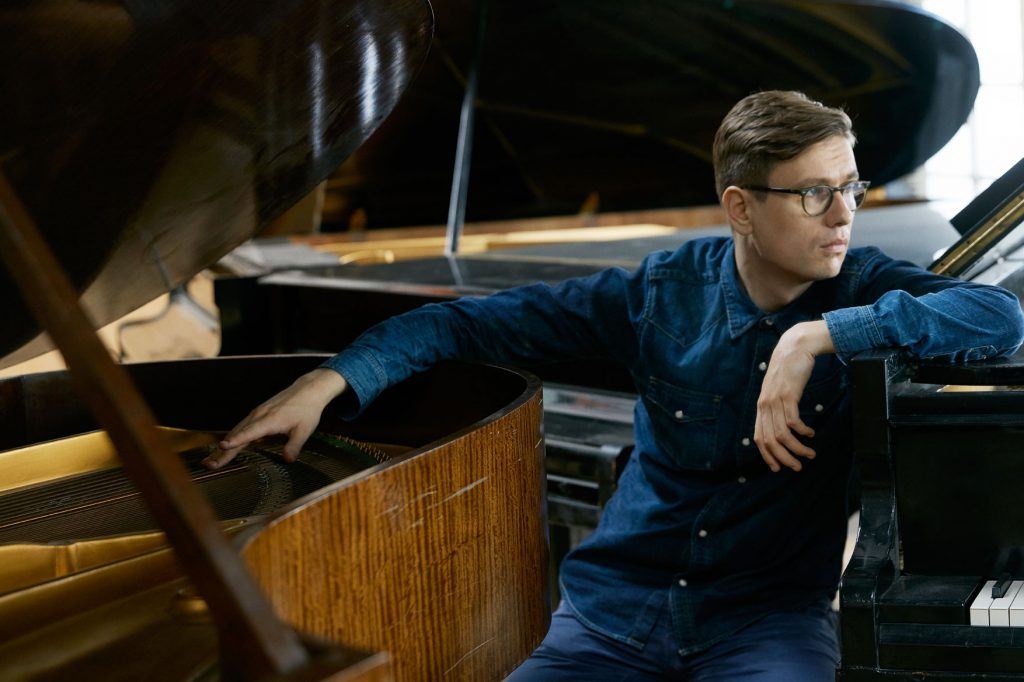San Diego Symphony Offers Stirring Mozart and Middling Mendelssohn
After Music Director Rafael Payare‘s season and tenure opening concert with the San Diego Symphony last weekend, I returned to the Jacobs Music Center this weekend full of high expectations. Payare’s cocky, adventure-filled account of Mason Bates’ time travel tone poem “Alternative Energy” followed by his alternately thrilling and probing Mahler Fifth Symphony were inspiring feats to write home about.

Víkingur Ólafsson [photo courtesy of the San Diego Symphony]
Yes, Payare was still electric on the podium, and the orchestra was producing glowing ensembles and rippling melodic flashes. But Saturday’s slight audience, a mere shadow of opening night’s full house, evidenced none of last week’s excitement and eager engagement with the orchestra’s performance. Their tepid applause to Víkingur Ólafsson’s smart, spirited Mozart Piano Concerto in C Minor, K 491, barely brought him back for an extra bow, much less an encore.
At the conclusion of Felix Mendelssohn’s complete incidental music to A Midsummer Night’s Dream, Op. 61, the audience gave a warmer response, but I suspect a portion of that applause was relief that the 70-minute conflation of music with short dramatic insertions from Shakespeare’s play by a team of 7 actors was finally over.
I appreciated hearing all of Mendelssohn’s score for his Op. 61, portions of which, e.g. the Overture and Wedding March, are achingly familiar, and other sections are almost never heard because they are underscoring to the spoken word. Payare and the orchestra infused these familiar sections with extraordinary vitality, beautifully balanced ensemble, and sparkling articulation. Like last week’s Mahler Symphony, Principal Horn Benjamin Jaber and his stalwart section filled the less familiar Intermezzo and Nocturne with sumptuous, burnished solos and mellow harmonies. Mendelssohn’s dramatic underscoring proved quite effective. Had he lived in a more recent century, he could have been the darling of the motion picture industry.
Mendelssohn calls for a chorus of high voices and two vocal soloists, but he does not give them a lot to do in his Op. 61. Soprano Tasha Koontz, mezzo-soprano Kira Dills-DeSurra, and the women of the San Diego Master Chorale sang with lustrous, well-produced voices when called upon, however. On screens placed above the orchestra, a series of impressionistic nocturnal woodland designs by the Chicago artist Mike Tutaj were projected to augment the composer’s already inventive musical impressions of Shakespeare’s haunted forest.
I was not won over by Gerard McBurney’s adaptation of Shakespeare, “a cut-down version of the original play,” to use his own description from the printed program notes. To extract the most affected, gossamer sections of A Midsummer Night’s Dream, vignettes filled with fairies dispensing magic potions, and toss them on the stage apron in front of the full symphony orchestra required a massive suspension of disbelief on the part of the audience. And having actors run around the orchestra to act from a narrow aisle between the seated women of the San Diego Master Chorale and the orchestra verged on the prankish. Of the seven San Diego actors in Mc Burney’s cast, only Jonathan Mastro’s charmingly irrepressible Puck and Jill Shellabarger’s genteel Titania created dramatically convincing facsimiles of Shakespeare’s characters.
When Mendelssohn composed his Op. 61, the intended performance mode would have been costumed actors on a stage with appropriate scenery and an orchestra playing out of site in a pit below the stage. The San Diego Symphony arrangement was too far from that model to work the magic of Mendelssohn’s splendid score.
Fortunately, Ólafsson did not need any magic to make his Mozart Piano Concerto a rewarding adventure. He relied on the enviable combination of a formidable piano technique and ample insight into the composer’s musical intentions. At the concerto’s outset, Payare and the orchestra set him up with a generous serving of the kind of roiling Sturm und Drang that Mozart saved for the dark key of C Minor. The young Icelandic virtuoso sailed through the score’s flashy runs, but he also developed Mozart’s musical ideas with pellucid articulation and structural clarity. The lack of these two virtues was a good part of what made Lang Lang’s account of this Mozart C Minor Piano Concerto so disappointing in last year’s season-opening concert under Edo de Waart’s direction.
Payare and Ólafsson gave the middle movement, a Haydnesque Larghetto in E-flat Major, the quiet, transparent treatment it required, and the woodwinds’ dulcet sonorities coupled with subtly taperd phrasing added to movement’s allure. For the rousing finale, mostly back in the opening dark C Minor key, Ólafsson displayed his most assertive playing, and the orchestra supported him splendidly.
Payare opened the concert with Venezuelan composer Antonio Estévez’ shimmering tone poem “Mediodia en el llano” (“Midday on the Plains”). With its calm, sustained lines, this short piece suggests an austere landscape using modal, widely spaced harmonies, the kind that Aaron Copland favored in his middle period. Happily, Estévez’ eventually gets around to indulging a lush melody or two—something Copland would not have given his listeners—before he signs off.
I hope Payare will present a wide selection of music by Latin American composers during his tenure here. Too many North American conductors believe if they play Silvestre Revueltas’ “Sensamayá” once every 20 years they’ve fulfilled their “quota” of Latin American music.
The San Diego Symphony performed this program October 10 & 11, 2019, in the Jacobs Music Center’s Copley Symphony Hall. The performance of October 12 was attended for this review.

Ken Herman, a classically trained pianist and organist, has covered music for the San Diego Union, the Los Angeles Times’ San Diego Edition, and for sandiego.com. He has won numerous awards, including first place for Live Performance and Opera Reviews in the 2017, the 2018, and the 2019 Excellence in Journalism Awards competition held by the San Diego Press Club. A Chicago native, he came to San Diego to pursue a graduate degree and stayed.Read more…
